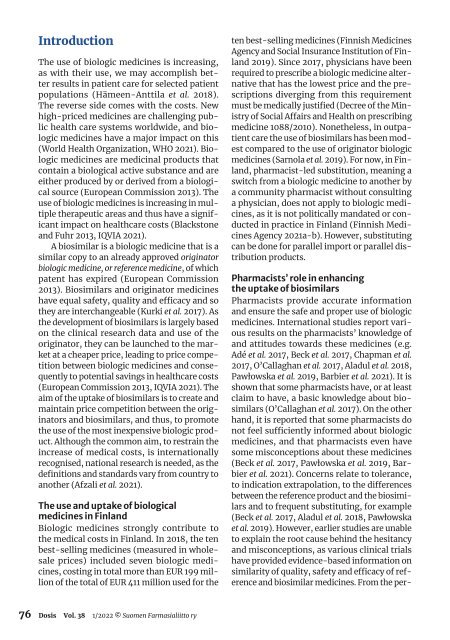DOSIS 1/2022
Farmaseuttinen aikakauskirja DOSIS 4/2021 vol.37 5uomen Farmasialiitto ry
Farmaseuttinen aikakauskirja DOSIS 4/2021 vol.37 5uomen Farmasialiitto ry
You also want an ePaper? Increase the reach of your titles
YUMPU automatically turns print PDFs into web optimized ePapers that Google loves.
Introduction<br />
The use of biologic medicines is increasing,<br />
as with their use, we may accomplish better<br />
results in patient care for selected patient<br />
populations (Hämeen-Anttila et al. 2018).<br />
The reverse side comes with the costs. New<br />
high-priced medicines are challenging public<br />
health care systems worldwide, and biologic<br />
medicines have a major impact on this<br />
(World Health Organization, WHO 2021). Biologic<br />
medicines are medicinal products that<br />
contain a biological active substance and are<br />
either produced by or derived from a biological<br />
source (European Commission 2013). The<br />
use of biologic medicines is increasing in multiple<br />
therapeutic areas and thus have a significant<br />
impact on healthcare costs (Blackstone<br />
and Fuhr 2013, IQVIA 2021).<br />
A biosimilar is a biologic medicine that is a<br />
similar copy to an already approved originator<br />
biologic medicine, or reference medicine, of which<br />
patent has expired (European Commission<br />
2013). Biosimilars and originator medicines<br />
have equal safety, quality and efficacy and so<br />
they are interchangeable (Kurki et al. 2017). As<br />
the development of biosimilars is largely based<br />
on the clinical research data and use of the<br />
originator, they can be launched to the market<br />
at a cheaper price, leading to price competition<br />
between biologic medicines and consequently<br />
to potential savings in healthcare costs<br />
(European Commission 2013, IQVIA 2021). The<br />
aim of the uptake of biosimilars is to create and<br />
maintain price competition between the originators<br />
and biosimilars, and thus, to promote<br />
the use of the most inexpensive biologic product.<br />
Although the common aim, to restrain the<br />
increase of medical costs, is internationally<br />
recognised, national research is needed, as the<br />
definitions and standards vary from country to<br />
another (Afzali et al. 2021).<br />
The use and uptake of biological<br />
medicines in Finland<br />
Biologic medicines strongly contribute to<br />
the medical costs in Finland. In 2018, the ten<br />
best-selling medicines (measured in wholesale<br />
prices) included seven biologic medicines,<br />
costing in total more than EUR 199 million<br />
of the total of EUR 411 million used for the<br />
ten best-selling medicines (Finnish Medicines<br />
Agency and Social Insurance Institution of Finland<br />
2019). Since 2017, physicians have been<br />
required to prescribe a biologic medicine alternative<br />
that has the lowest price and the prescriptions<br />
diverging from this requirement<br />
must be medically justified (Decree of the Ministry<br />
of Social Affairs and Health on prescribing<br />
medicine 1088/2010). Nonetheless, in outpatient<br />
care the use of biosimilars has been modest<br />
compared to the use of originator biologic<br />
medicines (Sarnola et al. 2019). For now, in Finland,<br />
pharmacist-led substitution, meaning a<br />
switch from a biologic medicine to another by<br />
a community pharmacist without consulting<br />
a physician, does not apply to biologic medicines,<br />
as it is not politically mandated or conducted<br />
in practice in Finland (Finnish Medicines<br />
Agency 2021a-b). However, substituting<br />
can be done for parallel import or parallel distribution<br />
products.<br />
Pharmacists’ role in enhancing<br />
the uptake of biosimilars<br />
Pharmacists provide accurate information<br />
and ensure the safe and proper use of biologic<br />
medicines. International studies report various<br />
results on the pharmacists’ knowledge of<br />
and attitudes towards these medicines (e.g.<br />
Adé et al. 2017, Beck et al. 2017, Chapman et al.<br />
2017, O’Callaghan et al. 2017, Aladul et al. 2018,<br />
Pawłowska et al. 2019, Barbier et al. 2021). It is<br />
shown that some pharmacists have, or at least<br />
claim to have, a basic knowledge about biosimilars<br />
(O’Callaghan et al. 2017). On the other<br />
hand, it is reported that some pharmacists do<br />
not feel sufficiently informed about biologic<br />
medicines, and that pharmacists even have<br />
some misconceptions about these medicines<br />
(Beck et al. 2017, Pawłowska et al. 2019, Barbier<br />
et al. 2021). Concerns relate to tolerance,<br />
to indication extrapolation, to the differences<br />
between the reference product and the biosimilars<br />
and to frequent substituting, for example<br />
(Beck et al. 2017, Aladul et al. 2018, Pawłowska<br />
et al. 2019). However, earlier studies are unable<br />
to explain the root cause behind the hesitancy<br />
and misconceptions, as various clinical trials<br />
have provided evidence-based information on<br />
similarity of quality, safety and efficacy of reference<br />
and biosimilar medicines. From the per-<br />
76 Dosis Vol. 38 1/<strong>2022</strong> © Suomen Farmasialiitto ry

















